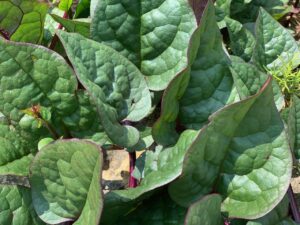By volunteer
By Tony Jevans and Cliff Keller

Malabar spinach is a heat-loving garden green. Also known as Indian spinach, Ceylon spinach, climbing spinach, vine spinach, Basella alba, and Basella rubra, it is a warm-weather vegetable that originates from Asia where it is used widely. Basella rubra is more commonly grown as an ornamental plant because of its purple-red vine color.
A major advantage in growing Malabar spinach is that it does not bolt and turn bitter as soon as the temperature rises. It is frost-sensitive, creeps when the weather is cool, but grows rapidly when the temperature gets in the 90’s.
 The vine should be trellised and can be grown with the same trellis as peas. It is grown as an annual but is self-seeding. Most families will find having just a few plants adequate for their needs. Malabar spinach can be started from seed, directly sown, or transplanted from cuttings. It grows best in full sun in most consistently moist soils but prefers fertile soil with a pH 6.5 to 6.8. This spinach is easy to care for and grows well when planted directly in the soil, in raised beds, or even in containers. If not grown with a trellis, the vines can sprawl and become a ground cover.
The vine should be trellised and can be grown with the same trellis as peas. It is grown as an annual but is self-seeding. Most families will find having just a few plants adequate for their needs. Malabar spinach can be started from seed, directly sown, or transplanted from cuttings. It grows best in full sun in most consistently moist soils but prefers fertile soil with a pH 6.5 to 6.8. This spinach is easy to care for and grows well when planted directly in the soil, in raised beds, or even in containers. If not grown with a trellis, the vines can sprawl and become a ground cover.
Harvesting of Basella alba is 50 days for baby greens and 85 days to full size greens.
Lack of moisture will promote flowering and bitter greens. Mulching the plant is essential, along with consistent watering. Take care not to over-water and avoid spraying the leaves to prevent the spread of fungal diseases.
High nitrogen fertilizers should be utilized during initial planting and then every 3 to 4 weeks during the growing season to get maximum leaf production. Frequent pruning and harvesting of the spinach is good for the plant and promotes more leafy and bushy growth.
Malabar spinach can be eaten raw in salads or cooked. It is a natural substitute for dishes that utilize traditional spinach. Younger leaves are best-suited to eat, especially if used in a salad. It is best eaten fresh but can be refrigerated for 2-5 days. For longer storage, blanch the leaves and then freeze.
The Basella rubra variety can be located in the south bed of the Edible Garden as well as next to the Isaac Café.

